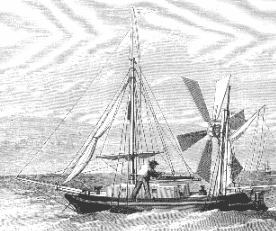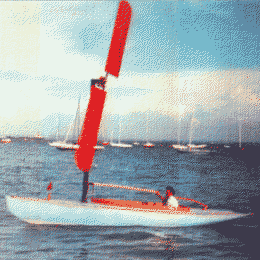 Some of you may not know that the first wind turbine boat to cross the Atlantic did so in 1870. [See correction]. That is now 125 years ago, and I do not think that the record which this boat set for a wind-turbine-boat crossing has been seriously attempted, let alone beaten. I know that Leonardo da Vinci and Jacob Bernoulli and maybe a few other people did some calculations and drawings and took out patents earlier than 1870, but as far as I have been able to discover, the first wind turbine boat which was actually built was this one.
Some of you may not know that the first wind turbine boat to cross the Atlantic did so in 1870. [See correction]. That is now 125 years ago, and I do not think that the record which this boat set for a wind-turbine-boat crossing has been seriously attempted, let alone beaten. I know that Leonardo da Vinci and Jacob Bernoulli and maybe a few other people did some calculations and drawings and took out patents earlier than 1870, but as far as I have been able to discover, the first wind turbine boat which was actually built was this one.
Illustrated London News, June 1870
This picture is an artist's impression from the Illustrated London News of 1870, and I do not know how accurate it is. It shows a converted lifeboat called City of Ragusa, only 20' long, in which two men and a dog crossed the Atlantic in 1870 - this was the first recorded two-man East to West crossing, and probably the smallest ocean-going yacht of its day. It was owned and sailed by an Irishman named John Buckley, who had the idea that the boat would be able to sail directly upwind without tacking by using the wind turbine to drive a propeller. That was why he did the crossing from East to West, into the wind.
This chap Buckley was a real eccentric, who had previously been a soldier in the Pope's army, and then the master of a large vessel in the China trade. He bought this lifeboat after it had brought 14 men to the Isle of Man after its original ship had sunk in the Irish Channel.
They set out from Liverpool in June 1870 with enough food for three months and took about that long to reach Boston in September 1870 - which was a very accurate time estimate, and not a bad time for such a small boat with no modern equipment. 96 days is the time for any other windmill boat to beat - surely that should be possible with modern technology ? Unfortunately, there is no information at all about whether they actually used the wind turbine during the voyage, or about how well it worked if they did. Still, 96 days was not a bad time for a 20' boat on an East to West passage in the 1870's, so maybe they did use it.
 Anyway, Buckley was so underwhelmed with publicity that very little more seems to have happened until 1920, when a Frenchman named Constantin built a wind turbine boat called Bois de Rose and sailed it up the river Seine directly upwind.
Anyway, Buckley was so underwhelmed with publicity that very little more seems to have happened until 1920, when a Frenchman named Constantin built a wind turbine boat called Bois de Rose and sailed it up the river Seine directly upwind.
 You might think that that would have proved something to somebody, but nothing more happened until 1933, when this boat was built by Lord Brabazon (well, he wasn't a Lord yet back in 1933, but you know who I mean). This one, unlike the previous two, is an autogiro, which means that it is not driving a propeller - the wind turbine is being used the same way as a sail. This is the earliest autogiro boat that I have found, and I think that we can safely credit Lord Brabazon with the original concept of using the turbine force to drive a boat directly, since all the other people before him had only thought of using the turbine to drive a propellor. After all, the aircraft autogiro was only invented a couple of years earlier in 1930.
You might think that that would have proved something to somebody, but nothing more happened until 1933, when this boat was built by Lord Brabazon (well, he wasn't a Lord yet back in 1933, but you know who I mean). This one, unlike the previous two, is an autogiro, which means that it is not driving a propeller - the wind turbine is being used the same way as a sail. This is the earliest autogiro boat that I have found, and I think that we can safely credit Lord Brabazon with the original concept of using the turbine force to drive a boat directly, since all the other people before him had only thought of using the turbine to drive a propellor. After all, the aircraft autogiro was only invented a couple of years earlier in 1930.
Photo: F. Sinclair
This boat is called KESTREL, and the hull is an 1896 Bembridge Redwing. This class has an unlimited sail plan - you can do whatever you like as long as the area is less that 200 sq. ft. So Lord Brabazon tried a whole lot of different sail rigs, including this one, which had a blade area of only 30 sq ft. King George V, who knew a lot about yachts, said "I have never seen a yacht sail so close to the wind".
Unfortunately, there was an accident in Cowes Harbour - Lord Brabazon shouted out "Let her go", and his crew let go of the rotor instead of the boat, and then it could not be stopped, because the brake wasn't strong enough. It was eventually stopped, after demolishing the next boat along. The moral of this tale is that you should be a bit more specific when giving instructions to your crew.
Lord Brabazon then got involved in some other project, so the boat lay in a shed for 60 years until it was restored by a classic boat enthusiast named Maurice Wilmot, who has had it put back exactly as it was in 1933, except that it now has a stronger brake on the rotor. This restoration was done by the process of removing each bit of wood and replacing it with an identical new bit of wood. Maurice Wilmot has a collection of restored old boats, including other Redwings. Since the 1896 Redwings are having their centenary in 1996, there will probably be some publicity about them, and it is likely that this boat and Maurice Wilmot will be in the news again shortly, if you watch the yachting press and particularly the magazine Classic Boat. I have sailed around Cowes harbour in it, and it certainly goes. There is a video of it in action. A clip of this may be added to this web page at a later date.
Of course, Lord Brabazon was not yet an AYRS member when he built this boat in 1933, because AYRS had not yet been started, and by the time he became our first President twenty four years later in 1957, he had given up on this particular project, so I suppose we can't really call it an AYRS project.
Table of Contents | Previous Chapter | Next Chapter
e-mail to:fnsnclr@gmail.com